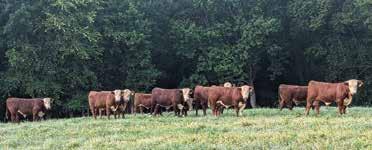
3 minute read
President’s Comments
A LOOK INTO OUR FUTURE
by Sally Wingler, THA President
Advertisement
Happy Fall You All!
It is hard to believe that we are now in the last quarter of the year 2021. With that in mind, I thought it would be a good time to take a look into our future. What can the Tennessee Hereford Association do to revive and renew its members and maintain the youthful zest and enthusiasm that is so necessary to growth and progress?
More than a hundred years ago, Oliver Wendel Holmes, an American poet, who most of us have studied, shared this bit of wisdom. The great thing in this world is not so much where we stand, as in what direction we are moving. We must sail sometimes with the wind and sometimes against it, but we must sail and not drift nor lie at anchor. We are the captain of destiny therefore, we must steer clear of obstacles that contribute to the slowdown and stagnation that accompanies aging and maturation.
We know of firms that are “on their toes “ and others “that are in a rut”. Universities know of departments that are enjoying exceptional vitality while others have gone to seed. When organizations are young they are flexible and willing to try anything. As the organization ages,vitality diminishes, flexibility gives way to rigidity and there is a loss of capacity to meet challenges from other directions. In the ever renewing society what matters is a framework within which continuous innovation, renewal and rebirth can occur.
First we must realize that people make cattle, cattle do not make people. The Hereford breed is the result of what people have done to it. Generally speaking, progress has been made as the result of man’s thinking and planning. The Tennessee Hereford Association must be accountable to its members, accessible to the people it serves, and responsive to the change and needs of the industry.
Membership involvement is the key to keeping an organization vibrant and alert. All members must be made to feel that they are a vital part of the plans and purposes. The organization must be open and honest with its members. The least member must have the same voice and access as the strongest or largest.
The breed association must be everybody’s experience. Rules must apply to all, but the fewer rules the better the organization can function in harmony and cooperation. Accounts must be open and records accessible. Leaders must have the complete confidence of its membership in its integrity and its motives. An important philosophy in the continued growth of an organization is that the idea lives on.
The greatest and most genetically efficient breed developed will only continue to be so if the leadership remains the confidence of the public and its credibility with the industry. As much as the future of the Hereford breed is totally in the hands and minds of the breeders, a logical, workable, and efficient organization is the key to breed success. One of the greatest mistakes made by an organization is to invest all authority in the Board of Directors. In order for an organization to function efficiently, authority must be delegated so decisions may be made expediently within the breed framework of policy established by a board of elected leaders.
The goal of the Tennessee Hereford Association should be to develop and perpetuate a breed of cattle that will economically meet the needs and desires of the consumers. Recognizing the fact that consumer needs are ever subject to change requires a breed association to be alert and sensitive to the need of changing standards and breed objectives. A study of the beef industry has taught us many things, but the impressive lesson we have learned is that breeds that have resisted have become extinct or at best of secondary importance, while those that have sinsed changing needs and adapted to change have grown and prosper. Today records are available so buyers of commercial animals and replacement seed stock can obtain specific information. Therefore, the cattlemen are swayed more by the true economic values and traits that relate to volume and value of product. Once the primary values are established then the secondary aim is to determine how the breed can be preserved without affecting the function of production efficiency.
This article is intended to stimulate some thought and inspiration for the Tennessee Hereford Association, because I would like it to be the very best. Thank you for being one of its members.


